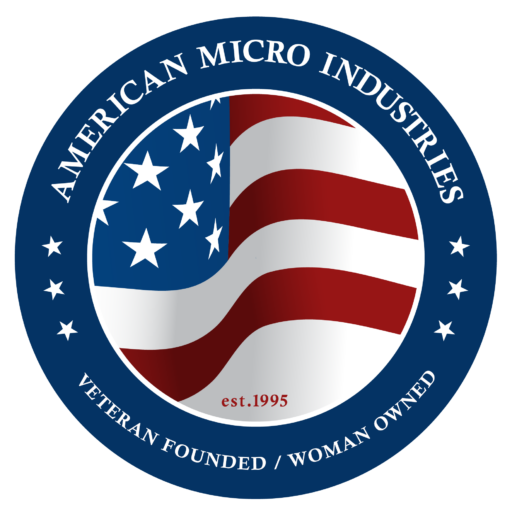CNC machining is an integral part of many industries — getting the tools and parts you need at an accuracy that’s tough to beat. Businesses are often looking for ways to trim their budgets — and CNC machining cost reduction is no exception. To reduce CNC machining prices, you should first understand the machining process and various factors that affect the price.
Find out how you can tweak or revise your CNC design to be more compatible with CNC machines and significantly reduce the cost.
How to Calculate CNC Machining Costs
CNC machining costs will vary depending on a couple of things, including the length of time required to complete the project as well as the specific machine used, like three- and five-axis machines. CNC machining shops typically set their own hourly rates for their various types of machines. For example, five-axis CNC machines often cost around $100 per hour, while three-axis machines typically cost less.
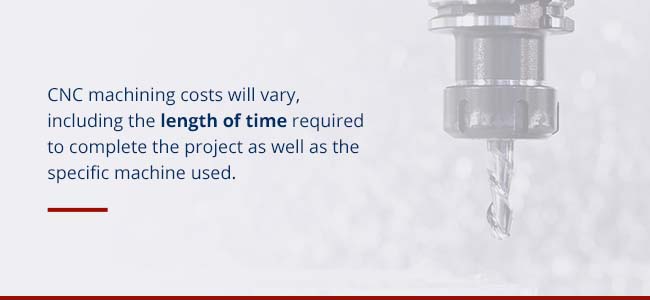
Remember that these are only the cost of running the CNC machines. These can serve as a baseline, though you’ll also want to think about the cost of labor. Additionally, several other factors can affect the price of CNC parts, which we cover in the next section. Because prices can vary, it’s best to consult potential CNC shops before committing to your order so you have an idea of how it will affect your budget.
Learn About Our CNC Machining Services
What Impacts the Cost of CNC Parts?
If you’re interested in CNC machining cost reduction, first you have to understand the factors that impact the cost of CNC parts — machining time, start-up costs, material costs and more. Here is some background information on each of these factors that can be used to ultimately reduce production costs:
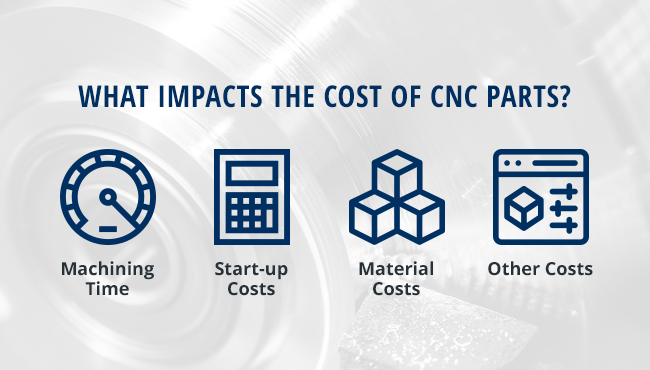
- Machining time: This is usually the primary cost driver when it comes to CNC machining. As a rule of thumb, the longer a part takes to machine, the more it will cost.
- Start-up costs: These costs are fixed. They are in place to cover the cost of CAD file preparation and product planning. For small volumes, start-up costs can be significant.
- Material costs: The cost of the bulk material you choose and how easy or hard the material is to machine is another big contributor to the cost of CNC machining.
- Other manufacturing costs: Some CNC machined parts come with special requirements — like tight tolerances or thin walls. These often require specific tools, more and additional processing steps and lower machining speeds. All of these factors can impact the machining time, which ultimately drives the cost up.
- Material finish: Adding a finish to your parts can improve the appearance and make the part more resistant to harsh environments. While this can be beneficial, it will surely increase the machining cost.
CNC Machine Costs
There are many types of CNC machines you can choose from when you hire a company for your project. Some machines are more expensive for companies to run and maintain operation, which can affect the price you pay to use it. For example, 3-axis machines are more standard, so they may cost between $35-$40 per hour. Other machines, like multi-axis machines, are more complex to run, so they’ll cost more — typically between $75-$120 per hour.
The price of the machine used will vary based on multiple factors, including a company’s pricing and how much they need to pay their operators. It’s best to speak to the company before completing the project to understand their pricing per machine.
Tips for Reducing CNC Machining Cost
To help with cost reduction, you can make changes in CNC machining time, start-up costs, materials costs and more. There are some product requirements that you won’t be able to change, but taking steps to ensure your design is optimized can significantly reduce costs. Here are a few of our tips for reducing CNC machining costs.
1. Rounded Internal Corners
Sharp, 90-degree corners require machines to stop, the part to be rotated, and then the process continues. As you can imagine, these additional steps take up machining time and often end up costing you extra money. Making changes to the internal corner designs of your piece can have an impact on CNC machining cost reduction.
If you adjust your design to include rounded corners, the machine can run continuously to create your part, and you’re likely to decrease your bottom line. Take it one step further and make sure the radius of your internal corners is at least 1/3 the depth of the cavity. Larger radii at the corners mean larger tools can cut them efficiently — instead of a small tool having to go over a corner with a smaller radius multiple times.
2. Avoid Deep Pockets
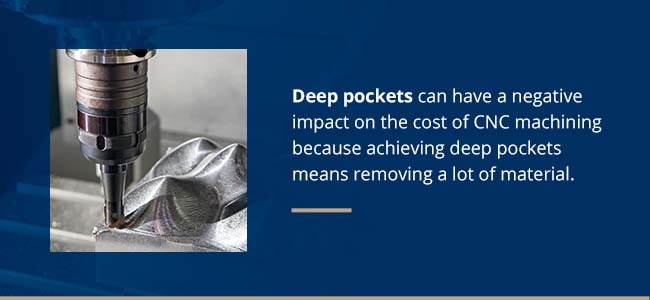
Deep pockets can have a negative impact on the cost of CNC machining because achieving deep pockets means removing a lot of material. Removing material is time-consuming and may require a special tool to reach the depth you want.
Try to limit the depth of pockets in your design to four times the length. CNC tools do have a limit when it comes to cutting pockets — ideally, a depth of up to two to three times their diameter. Cutting up to four times the diameter is possible, but it will cost you more money.
3. Limit Use of Tight Tolerances
When your part design includes a tight tolerance, it drives up the cost because it increases the machining time and adds a manual inspection. Unfortunately, tight tolerances are particularly tough to achieve on the internal surfaces of your part, as machining holes and other cavities can develop burrs on the edges. These burrs require an additional step beyond the manual inspection — deburring. Deburring is a manual and time-consuming process that also drives up the cost of CNC machining.
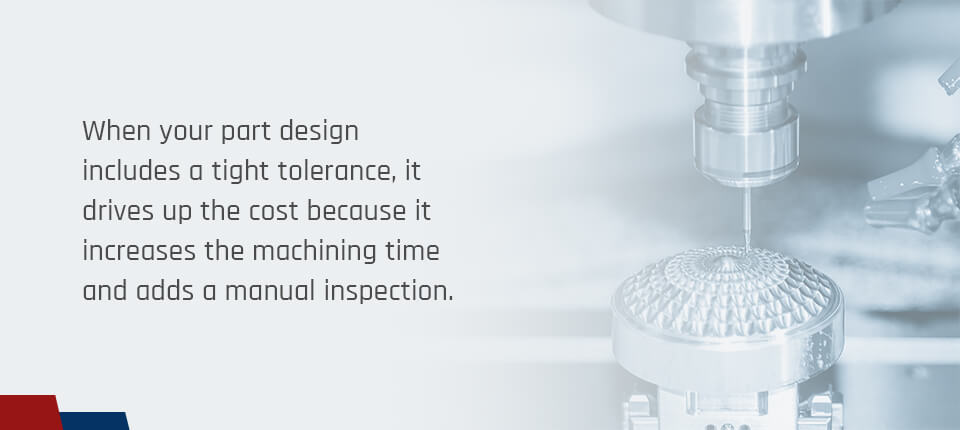
If a specific tolerance isn’t defined by the design, the standard tolerance of ± 0.010 thousandths or better is used. This standard tolerance works well for many features, so you should reconsider any tight tolerances you have and only specify tight tolerance when it’s necessary. If you have advanced design knowledge, you can further reduce the cost of CNC machining, as the tolerances that come with them are usually looser.
One final note regarding tolerances — the numbers that represent your dimensions are critical, as they specify the level of accuracy you require for your part. In CNC machining, that level of accuracy translates to what tool will be used to machine it. The more decimal places you include, the more intricate the tool, and the higher the cost. Make sure you eliminate all unnecessary decimal points from your design.
4. Expand Thin Walls
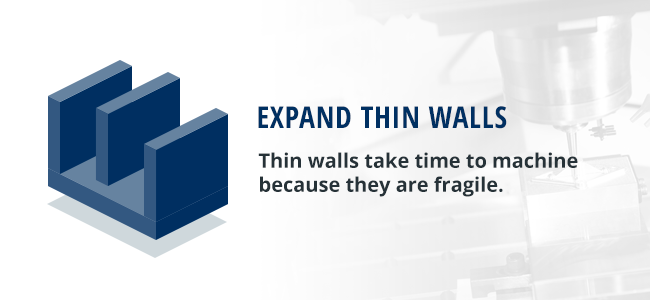
Thin walls take time to machine because they are fragile. Thin walls are machined through multiple passes with low setting depths to avoid any errors or fractures. A common cause of thin walls has to do with the placement of holes and threads near the edge of the part. Place them strategically.
Thick walls are more stable and cost less to machine. As long as the weight isn’t a concern, design metal parts with walls thicker than 0.8 millimeters and plastic parts with walls thicker than 1.5 millimeters.
5. Limit the Length of Threads
Threads longer than 1.5 times the diameter of the hole don’t make the connection any stronger, and threads that are longer than necessary may be the cause of additional costs because special tools may be required to create them.
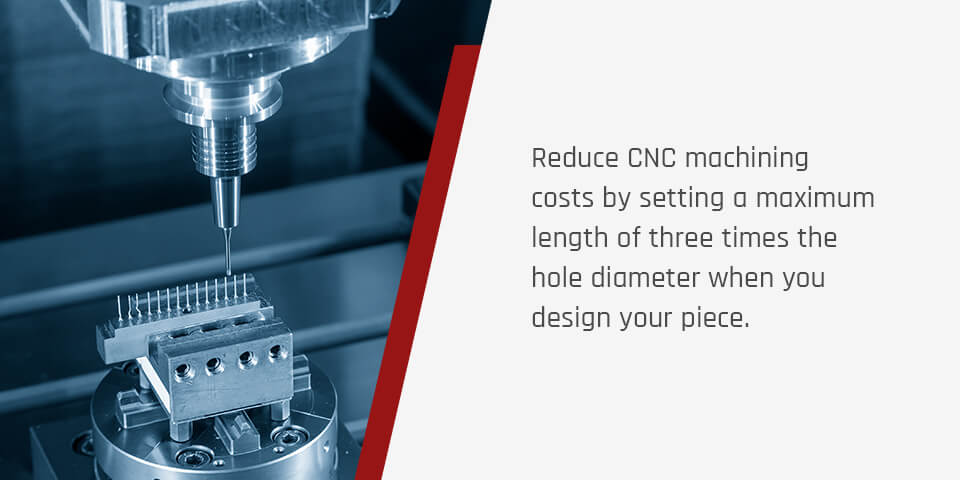
Reduce costs by setting a maximum length of three times the hole diameter when you design your piece. Remember that threads in blind holes should have an additional half diameter, unthreaded, at the end of the hole.
6. Optimize Tapped Holes
The two factors that affect cost when it comes to tapped holes are depth and tap size. As we mentioned, increasing the length of a thread beyond a point doesn’t make the part any stronger. Going deeper than three times the hole diameter comes with an increased risk of breaking the tap and additional time — both of which can increase costs. Very small threads also add to costs, as they require hand tapping, which adds time and risk.
Instead, limiting your depth to three times the hole diameter and sticking to standard tap sizes in your design can help with CNC machining cost reduction. For example, your design may request 3-48 taps, but shifting to 4-40 taps, a more common size, could save you money. Also, try to keep threaded holes greater than 2-56 inches.
7. Leverage Standard Drill Sizes
If you plan accordingly and make sure the holes in your part are standard size, CNC machines can use drill bits to create holes quickly and efficiently. However, non-standard sizes often require the use of an end mill tool, which can negatively impact the cost. The depth of the holes also has an effect — while holes as deep as 10 times the diameter can be created, they’re tough to machine and will cost you more.
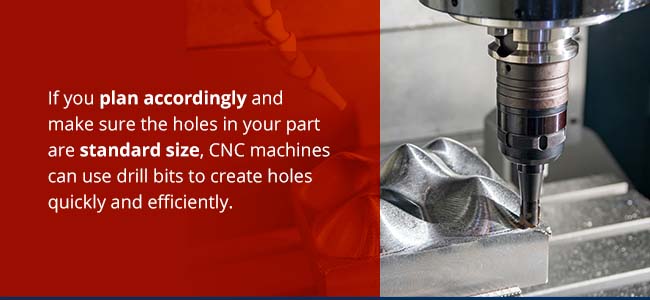
To maximize CNC machining cost reduction, if you have a hole diameter of up to 10 millimeters, design it in an increment of 0.1 millimeters. For anything above 10 millimeters, use an increment of 0.5 millimeters. If you’re designing in inches, refer to the fractional-inch drill bit sizes and use fractions of an inch. Regardless of which size hole, make sure the length of the hole doesn’t go above four times the diameter.
8. Avoid Multiple Finishes
The finish of your CNC machined part helps protect it against harsh environments and often improves its appearance. Unfortunately, it also drives the cost up. Taking it another step further and asking for multiple finishes on one part increases the cost even more.
If you want to save money, consider choosing the as-machined finish for the entire piece. Only ask for multiple finishes when you need them.
9. Split Up Complex Parts
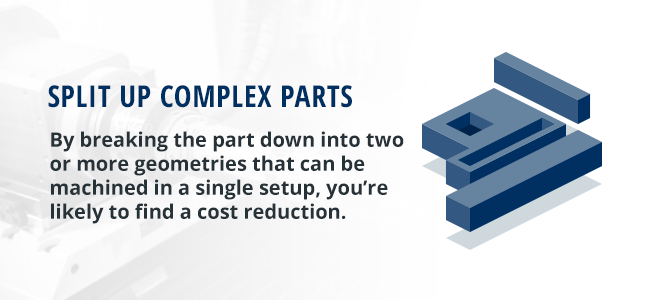
If you have a complex part — such as intricate geometries, rotating or repositioning required — machining your part is likely going to involve a custom fixture, manual rotation, repositioning or a multi-axis CNC system. All of these come at a cost.
If you aren’t able to make your part any less complex, you still may be able to find a way to reduce CNC machining costs by splitting the part into two or more separately machined parts that can be assembled to create the part you need. By breaking the part down into two or more geometries that can be machined in a single setup, you’re likely to find a cost reduction.
10. Avoid Small Features With High Aspect Ratio
Any parts that have extreme width-to-depth ratios are usually difficult to machine. For example, small features that have a high width-to-height aspect ratio are difficult to machine because they are prone to vibrations. As with many of the other aspects of machining, if it’s tough to machine, it drives the cost up.
To reduce CNC machining costs, design all features with a width-to-height aspect ratio that’s less than four and consider connecting them to a wall or adding brace support to improve stiffness.
11. Order Larger Quantities
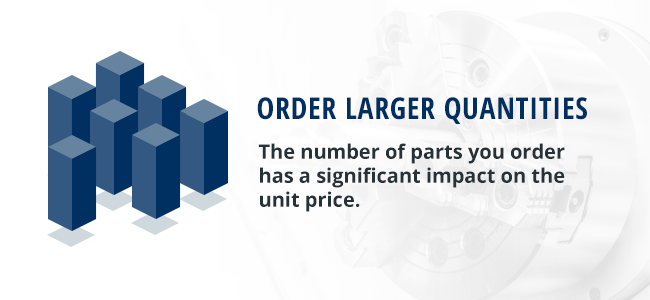
The number of parts you order has a significant impact on the unit price. What’s known as the economies of scale can be a powerful tool as you figure out how to reduce costs. Increasing the quantity from one to 50 could decrease the unit price by more than 50%.
Consider ordering a higher quantity the next time you place an order.
Keep It Simple
The overall theme in many of these tips for reducing CNC machining costs is simplicity. When you design a complex part, it will likely require the help of special tooling or fixtures, several machine setups or special materials that will cost you more money.
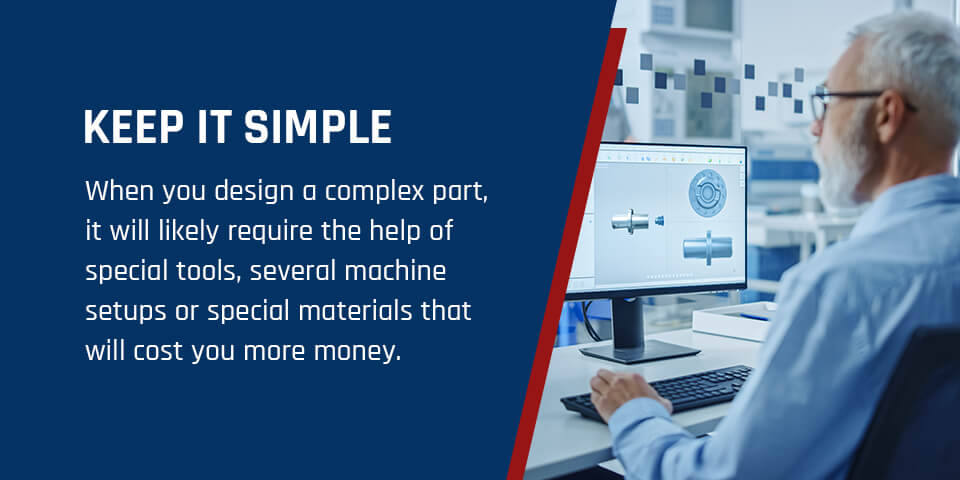
When you submit your next order for a quote, ask yourself the following questions to help you reduce the cost of CNC machining:
- Have I optimized my part using the Designing for Machinability guidelines? Learn how to optimize part design for CNC machining if you don’t already know.
- Are all the features of my part necessary for it to fully function?
- Could the part be split into multiple, simpler parts for machining, followed by assembly?
- Could I change the material to something that would be easier to machine and still meet my requirements?
CNC Machining From American Micro Industries
After you’ve applied each of our tips for reducing CNC machining costs to your design, you can be sure you’ve optimized your part for CNC machining. When you get to that point, you’re ready to find a CNC machining company that can bring your part to life — at an affordable cost.
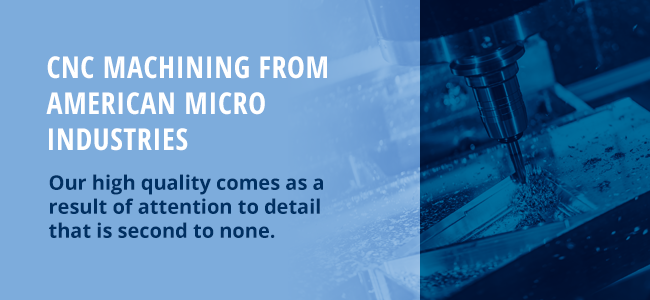
American Micro Industries is a CNC machining partner you can trust. Our high quality comes as a result of attention to detail that is second to none. We identify materials, produce parts and ship from one location. Our customers know they can count on us because we stand behind each and every one of our products and are willing to do what we can to ensure you’re satisfied with your CNC machined part.
Once you’ve optimized your design to reduce CNC machining costs and you’re ready to get a quote, call us at 1-866-765-9191 or submit your request online .

